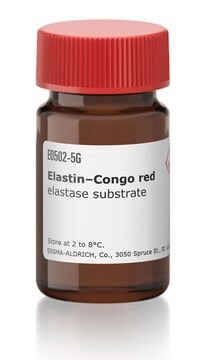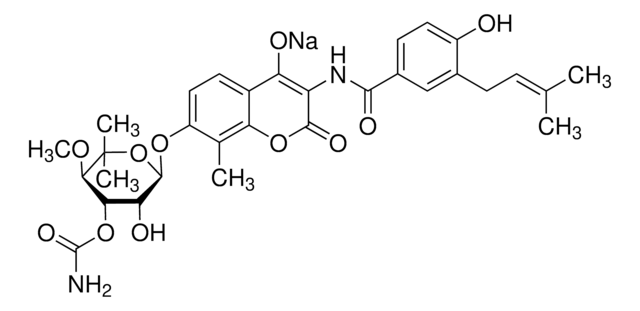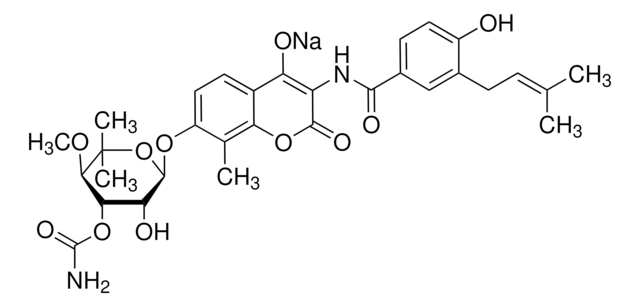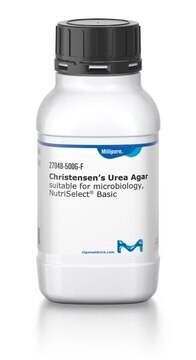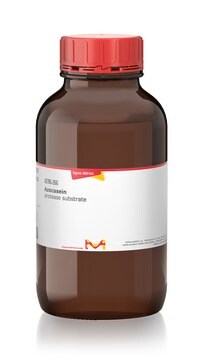D0690
DNA Gyrase from Escherichia coli
aqueous glycerol solution
Faça loginpara ver os preços organizacionais e de contrato
About This Item
Número MDL:
Código UNSPSC:
12352204
NACRES:
NA.54
Produtos recomendados
fonte biológica
Escherichia coli
Nível de qualidade
Formulário
aqueous glycerol solution
peso molecular
~374 kDa
concentração
≥2 unit/μL
técnica(s)
cell based assay: suitable
aplicação(ões)
cell analysis
Condições de expedição
dry ice
temperatura de armazenamento
−70°C
Informações sobre genes
Escherichia coli K12 ... gyrA(946614) , gyrB(948211)
Aplicação
DNA gyrase from Escherichia coli has been used in a study to investigate a comparative proteomic approach to better define Deinococcus nucleoid specificities. DNA gyrase from Escherichia coli has also been used in a study to investigate the role of the DnaK-ClpB bichaperone system in DNA gyrase reactivation.
Ações bioquímicas/fisiológicas
DNA gyrase is supplied as an A2B2 holoenzyme. The molecular mass of subunit A is 97 kDa and that of subunit B is 90 kDa. It catalyzes the ATP-dependent introduction of negative supercoils into relaxed DNA. DNA gyrase has been successfully converted into a type II topoisomerase by mutagenesis experiments.
Can be used to supercoil plasmids.
Definição da unidade
One unit of gyrase activity will supercoil 0.5 micrograms of pBR-322 DNA in 30 minutes at 37 °C.
Outras notas
Solution in 50% Glycerol containing Tris buffer, DTT and EDTA.
Código de classe de armazenamento
10 - Combustible liquids
Classe de risco de água (WGK)
WGK 1
Ponto de fulgor (°F)
Not applicable
Ponto de fulgor (°C)
Not applicable
Escolha uma das versões mais recentes:
Já possui este produto?
Encontre a documentação dos produtos que você adquiriu recentemente na biblioteca de documentos.
S C Kampranis et al.
Proceedings of the National Academy of Sciences of the United States of America, 93(25), 14416-14421 (1996-12-10)
DNA gyrase is unique among topoisomerases in its ability to introduce negative supercoils into closed-circular DNA. We have demonstrated that deletion of the C-terminal DNA-binding domain of the A subunit of gyrase gives rise to an enzyme that cannot supercoil
Alix Pantel et al.
Antimicrobial agents and chemotherapy, 56(4), 1990-1996 (2012-02-01)
Fluoroquinolone (FQ) resistance is emerging in Mycobacterium tuberculosis. The main mechanism of FQ resistance is amino acid substitution within the quinolone resistance-determining region (QRDR) of the GyrA subunit of DNA gyrase, the sole FQ target in M. tuberculosis. However, substitutions
Magali Toueille et al.
Journal of proteomics, 75(9), 2588-2600 (2012-03-27)
Compared to radiation-sensitive bacteria, the nucleoids of radiation-resistant Deinococcus species show a higher degree of compaction. Such a condensed nucleoid may contribute to the extreme radiation resistance of Deinococcus by limiting dispersion of radiation-induced DNA fragments. Architectural proteins may play
Teresa Lara-Ortíz et al.
Canadian journal of microbiology, 58(2), 195-199 (2012-01-24)
In Escherichia coli cells, an increase in temperature induces immediate DNA relaxation, followed by the fast recovery of DNA supercoiling. DNA gyrase, proteins synthesized during heat stress, and chaperone DnaK have been proposed to participate in this recovery. However, the
Valentina Monica et al.
Lung cancer (Amsterdam, Netherlands), 79(3), 228-235 (2013-01-02)
Thymic epithelial tumors include several entities with different biologic behavior. Chemotherapy is indicated in advanced disease, but limited data exist on gene expression correlation with the response to chemotherapeutic agents. A series of 69 thymic neoplasms (7 A-, 6 AB-
Nossa equipe de cientistas tem experiência em todas as áreas de pesquisa, incluindo Life Sciences, ciência de materiais, síntese química, cromatografia, química analítica e muitas outras.
Entre em contato com a assistência técnica

